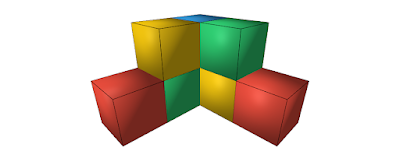Soma Cube Puzzles
My colleague Daniel Kline has been playing around with a novel set of puzzles to be solved with a Soma cube that should hopefully hit the website in coming months. I wanted to create something that was less reliant on gravity and friction and ended up with a slightly more traditional puzzle set.
Setup
For this puzzle you'll want to get a Soma cube. I got a magnetic one a while back that I'm fond of, but it's pretty pricey. Daniel found a cheap wooden one that works pretty well. Here they are:
Magnetic Soma cube ($15)
Luban Lock Soma cube ($4, possibly out of stock)
The folks at SUMM have a couple large scale versions that younger students especially enjoy, which are similar or identical to this model. George Hart has built large-scale models out of cardboard boxes. Lauren Siegel of MathHappens has written on making a Soma cube with modular origami.
Challenges
In each puzzle, it's your job to build the structure. As a clue, the number of blocks required is given, but it's your job to figure out which blocks. Solutions are not unique in many cases, so students might enjoy comparing solutions and hunting for others. Below are some 2-block and 3-block puzzles:
2 blocks
2 blocks
2 blocks
2 blocks
3 blocks
3 blocks
3 blocks
3 blocks
3 blocks
3 blocks
3 blocks
3 blocks
3 blocks
3 blocks
3 blocks
For slides of these puzzles and puzzles involving \(4\) or more blocks, click here.
Notes
Sometimes one puzzle differs from another by a single piece or by "hinging" one piece into another position. Other times, puzzles that look very similar require completely different pieces.
The fact that each piece only occurs once in the kit can help rule out partial solutions when the "hole" left is an already used block. For example, it's not possible to create a \(2 \times 2 \times 3\) rectangular prism like in puzzle 15 above using both an L and a Z tetromino. When working with the two pieces, you'll conclude there is only one way they could fit together and that the missing piece is a second L tetromino.
All of the blocks have volume \(4\) except for the single block with volume \(3\). If students assess the volume of a puzzle and see that it's not a multiple of \(4\), the volume-\(3\) block must be a part of any solution. As an added challenge, you can remove the number of blocks as a hint so that students have to determine the number of blocks on their own.
Extra Challenges
I focused on puzzles that have solutions, but more open-ended questions add a nice challenge. For example, we've seen that it's possible to make a rectangular prisms in the following sizes: \(2 \times 2 \times 3\), \(2 \times 2 \times 4\), \(2 \times 3 \times 4\), and \(3 \times 3 \times 3\). Are any other sizes possible?
The original Soma Manual focused mostly on puzzles involving all \(7\) blocks and they are quite challenging! You can look at the manual here.
















Comments
Post a Comment